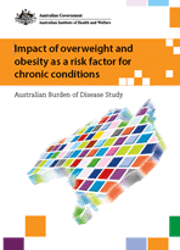Summary
Overweight and obesity is a major public health issue, with nearly 2 in 3 adults and 1 in 4 children in Australia considered overweight or obese (AIHW 2016c). The Australian Burden of Disease Study (ABDS) 2011 modelled the impact of overweight and obesity and showed it is one of the leading risk factors for ill health and death (AIHW 2016a).
This report updates and extends the findings reported in the ABDS 2011 to include burden in people aged under 25, revised diseases linked to overweight or obesity (based on the latest evidence), and estimates by socioeconomic group. This report also includes scenario modelling to assess the potential impact on future health burden if overweight and obesity in the population were to continue to rise or be reduced.
In total, 22 diseases resulting from overweight and obesity were included in this analysis. These comprised 11 types of cancer (7 were included in the ABDS 2011), 3 cardiovascular conditions, chronic kidney disease, diabetes, dementia, gallbladder disease, gout, back pain and problems, osteoarthritis and asthma.
Overall health impact of overweight and obesity
The enhanced analysis in this report indicates:
- 7.0% of the total health burden in Australia in 2011 was due to overweight and obesity
- 63% of this was fatal burden rather than non-fatal burden
- 84% was experienced between ages 45 to 84
- males experienced a greater proportion of burden from overweight and obesity (males 7.3% of total burden; females 6.6%)
- 53% of diabetes burden and 45% of osteoarthritis burden were due to overweight and obesity.
Overweight and obesity burden greatest in lowest socioeconomic group
The lowest socioeconomic group experienced rates of overweight and obesity burden that were 2.3 times those of the highest socioeconomic group.
Little change in rates of overweight and obesity burden between 2003 and 2011
Despite rising rates of overweight and obesity, the rate of burden was similar in 2003 and 2011 (after accounting for population increase and ageing). This was largely due to increases in some linked disease burden (such as diabetes and chronic kidney disease) being offset by decreases in other linked disease burden (such as coronary heart disease and stroke).
Around 14% of disease burden due to overweight and obesity could be avoided if the population’s body mass dropped slightly
An estimated 6% of future disease burden in 2020 due to overweight and obesity could be avoided if current increases in overweight and obesity in the population were halted (maintained at 2011 levels). Furthermore, 14% of disease burden due to overweight and obesity in the year 2020 could be avoided if the population at risk in 2011 reduced their body mass index (BMI) by 1 and these rates were maintained in 2020, compared with what would be the case if overweight and obesity continued to rise.
Summary
- Overall health impact of overweight and obesity
- Overweight and obesity burden greatest in lowest socioeconomic group
- Little change in rates of overweight and obesity burden between 2003 and 2011
- Around 14% of disease burden due to overweight and obesity could be avoided if the population’s body mass dropped slightly
1. Introduction
- Structure of this report
2. Methods
- Selected linked diseases and relative risks
- Determining overweight and obesity prevalence
- Theoretical minimum risk exposure distribution
- Quantifying overweight and obesity burden
- Socioeconomic group analysis
- Comparison with attributable burden in 2003
- Scenario modelling
3. Burden due to overweight and obesity
- Total overweight and obesity burden
- Which diseases account for the most burden due to overweight and obesity?
- Attributable burden by sex
- Was it due to fatal or non-fatal burden?
- How does the overweight and obesity burden vary by age?
- Children aged 5–14
- Adolescents aged 15–24
- Adults aged 25–44
- Adults aged 45–64
- Adults aged 65–84
- Adults aged 85+
- What proportion of burden for each linked disease is due to overweight and obesity?
- Detailed estimates for selected linked diseases
- Cardiovascular disease
- Cancer
- Diabetes
- Musculoskeletal conditions
- Chronic kidney disease
- Dementia
4. Variation across socioeconomic groups
5. Changes between 2011 and 2003
6. Scenario modelling
- Overweight and obesity prevalence in 2020
- Overweight /obesity burden comparison in 2020
- Scenario differences by age
7. Discussion
- Key findings
- Potential for disease burden prevention
- Strengths, limitations and future directions
- Strengths
- Limitations
- Using BMI as a measure of body mass
- Quantifying future disease burden due to childhood obesity and cohort effects
- Overweight and obesity prevalence and ABDS 2011 data
- Complexities with scenario modelling
- Future directions
- Conclusion
Appendix A: Detailed methods
Appendix B: Selection of relative risks
Appendix C: Additional tables
End matter: Acknowledgments; Abbreviations; Symbols; Glossary; References; List of tables; List of figures



